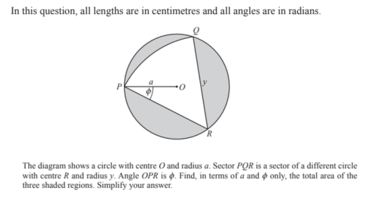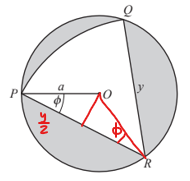Kulla_9289
Junior Member
- Joined
- Apr 18, 2022
- Messages
- 214
I have the attached question. I got [imath]\frac{1}{2}a^2(2π-sin(2Ø)-2cos(Ø))[/imath]. But the question asks me to write it in terms of [imath]a^2[/imath] and [imath]Ø[/imath] only. The process was lengthy but basically, I separated the circle into three parts and found the entire area for each of the sectors for each of the sectors; then, I subtracted the area of a triangle from the area of a sector; then, I added all the three subtracted areas of the shaded region to get to the answer above.
Attachments
Last edited:



